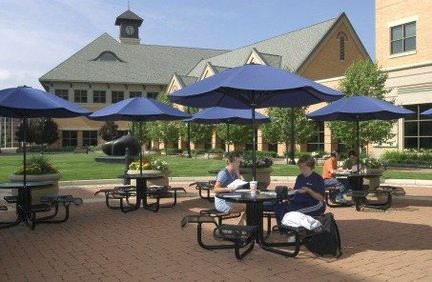Students opting for downtown housing

Courtesy Photo / Grand Rapids Press Students find living downtown to be a more attractive option than living in Allendale
Nov 28, 2011
For Grand Valley State University senior Lindsey McKenney, the decision to move downtown after three years in Allendale was an easy one.
“I was sick of Allendale, all my winter classes are at (the DeVos Center on Pew Campus) and since I’m old enough, there’s more a of a social life downtown,” McKenney said.
Like others who traded in their townhouses on 48th Street and on-campus apartment complexes for humble homes in downtown Grand Rapids, McKenney grew bored of her life in what she called a “reluctant college town.”
At her home on Lake Michigan Drive, McKenney lives with four roommates to keep the rent and utility payments low.
“There are way more bills and more responsibilities like raking leaves and shoveling snow,” she said. “But it’s totally worth it.”
American Realty of West Michigan’s Jared Behrens said many students who decide to move downtown do so in their junior or senior year of college and are primarily motivated by the prospects of cheaper rent and greater independence.
“Allendale (housing) is both pricey and bad quality … and it lacks stuff to do,” said Behrens, whose company focuses on buying, remodeling and renting distressed homes in areas where students tend to live. “Most of our rentals are in demand. People are looking and renting 10 months out.”
Behrens added that while there are many rentals available in Grand Rapids, quality houses are still scarce.
Staying ahead of the game
Jessica Enloe, a GVSU junior, almost lost out on a house she and her roommates wanted to rent for next fall. She said she had to get on top of things quickly to secure a house near the Lake Michigan Drive and Garfield bus stop on The Rapid’s Route 50.
“It’s almost like trying to get a place in Allendale, having to get organized so soon,” she said. “We actually put a deposit down the day we saw it. Well, I actually haven’t seen it, but the other three have.”
Some areas are more in demand by GVSU students than others, Behrens said, such as the northwest part of the city by GVSU’s Pew Campus and locations along The Rapid’s Route 50. Other hot spots for student housing are in Eastown and the Fairmount Hill area, he said.
“Most of the houses we work on (are) found through local realtors who find foreclosed homes,” he said. “For the most part we try to rehab the houses all the same. Tear them up from top to bottom and replace everything. For college students we try to add an extra bedroom most times to keep rent lower.”
Continued growth
A few blocks from McKenney’s house on Lake Michigan Drive, senior Nick Dow walks past four houses being renovated into student housing on his way to the bus stop from his National Avenue house, a sign of continued growth in his west side neighborhood.
Dow, who himself lives in a recently renovated house, said the homes undergoing renovations near him are intended to house students next year, who are seeking the same thing Dow is – something a little less expensive.
“We almost had someone live in our dining room this year, that would have gotten our rent a good bit below $300,” Dow said.
And Dow is not alone. With lower rent at the center of most decisions to move downtown, students such as senior Kaitlin Campbell go to great lengths to keep costs down in tough economic times, where many students find themselves scrimping and saving.
Currently, Campbell has eight roommates and counting slated to live with her next year in an effort to live cheaply.
“The west side is still gaining popularity especially as we see a tipping point of students in the neighborhood, but Grand Rapids is a big city and there are lots of nice places,” said Nathan Biller, a landlord who also owns homes rented to GVSU students.
Biller said growth in the area seems to be continuing despite troubles in the housing market in recent years, and said with the construction of the new William L. Seidman Center for the Seidman College of Business, he expects more students wanting to live in downtown Grand Rapids, with closer proximity to their classes and lower rent working in their favor.
“It’s exciting to see some areas turn into micro-college towns,” Behrens said.

























